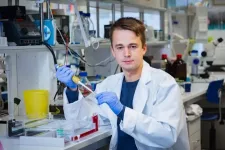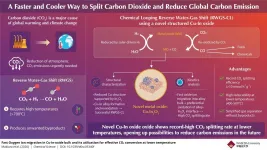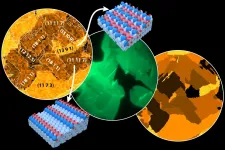Evolution in a test tube: these bacteria survive on deadly copper surfaces
2021-01-13
(Press-News.org) The descendants of regular wild-type bacteria can evolve to survive for a long time on metallic copper surfaces that would usually kill them within a few minutes. An international research team led by Martin Luther University Halle-Wittenberg (MLU) and the Bundeswehr Institute of Microbiology was able to produce these tiny survivalists in the lab and has been able to study them more closely. The team reports on its findings in Applied and Environmental Microbiology.
Bacterial infections are usually treated with antibiotics. However, in recent decades many pathogenic bacteria have developed an increasing tolerance to common drugs. So-called multidrug-resistant bacteria are of particular concern as they can no longer be combated with most antibiotics. Copper surfaces - for example on door handles - are a good weapon to fight these germs. "Copper surfaces are a sure-fire way to kill bacteria. Most bacteria die within minutes after landing on a copper surface," explains Professor Dietrich H. Nies, a microbiologist at MLU. Copper is a vital trace element for bacteria - but only in very small quantities. On the copper surfaces, however, the bacteria are literally flooded to death with copper ions because that they can no longer stave them off using their normal defence strategies.
Nies' research team wanted to find out if and how quickly two typical species of bacteria, Escherichia coli and Staphylococcus aureus, are theoretically able to adapt to survive on copper surfaces. The team therefore placed the bacteria on the surfaces for only a few minutes before returning them to a normal culture medium where they were allowed to recover. This process was repeated several times, with the survivors gradually being exposed to the deadly surface for longer and longer periods of time. Within three weeks, the researchers had produced bacteria that could survive for more than one hour on a copper surface. "Outside the laboratory, conditions are obviously not as ideal. But if copper surfaces are not cleaned regularly, insulating layers of grease can begin to form on them, which could produce a similar development over time," says Nies.
Using comprehensive genetic analyses, the team sought to understand why the bacteria no longer died on the surfaces. "We were unable to find a gene that made them resistant to the deadly effect of metallic copper surfaces," says Nies. Instead, the team observed a phenomenon among the surviving bacteria that was already known for quite some time, although in a slightly different manner: the bacteria's metabolism slowed down to a bare minimum and they fell into a kind of hibernation. Because most antibiotics aim to disrupt the metabolism of growing bacteria, they are almost completely ineffective against these special bacteria, which are also known as "persisters". "No matter how well an antibiotic works, there are always a handful of persisters in every generation," explains Nies. However, these are not considered antibiotic-resistant bacteria, because their offspring are once again susceptible to the drugs.
Normally only a tiny proportion of bacteria become persisters. However, in the case of the isolated bacteria, it was the entire population. Although they were able to grow just as fast as their predecessors, they were also able to rescue themselves by switching rapidly into an early state of persistence under adverse conditions. The scientists were concerned one additional thing they observed: "The bacteria also inherited this capability over 250 generations, even though the offspring had not come into contact with a copper surface," says Nies. The team therefore recommends that copper surfaces be cleaned regularly and thoroughly with special agents so that no persister bacteria can develop in the first place. At the same time, Nies points out that the use of copper surfaces is only one of many ways - including antibiotics - to effectively combat harmful bacteria.
INFORMATION:
Bleichert et al. Generation and analysis of mutant strains of Escherichia coli and methicillin-resistant Staphylococcus aureus obtained by laboratory selection to survive on metallic copper surfaces. Applied and Environmental Microbiology (2021). Doi: 10.1128/AEM.01788-20
ELSE PRESS RELEASES FROM THIS DATE:
2021-01-13
It is politically agreed and necessary for climate protection reasons that our entire economy becomes climate-neutral in the coming decades - and that applies to air travel, too. This is a technically feasible goal, and there are numerous ways to achieve it. ETH Professor Marco Mazzotti and his team have now compared the options that appear to be the easiest to implement in the short and medium term and evaluated them according to factors such as cost-effectiveness.
The ETH researchers conclude that the most favourable option is to continue powering aircraft with fossil fuels in future, but then remove the associated CO2 emissions from the atmosphere ...
2021-01-13
Fuchs' corneal dystrophy is one of the most common eye diseases diagnosed in almost 5% of the population of Europe aged 40 years or over. It is a hereditary eye disease that causes vision impairment and typically manifests in middle age. The first symptoms of the disease - blisters on the surface of your cornea - resemble cataract at first glance. The disease progresses from the centre of the cornea affecting all layers of the cornea. The progression of the disease varies from individual to individual and in severe cases results in vision loss.
The molecular neurobiology ...
2021-01-13
With ever-worsening climate change, there is a growing need for technologies that can capture and use up the atmospheric CO2 (carbon dioxide) and reduce our carbon footprint. Within the realm of renewable energy, CO2-based e-fuels have emerged as a promising technology that attempts to convert atmospheric CO2 into clean fuels. The process involves production of synthetic gas or syngas (a mixture of hydrogen and carbon monoxide (CO)). With the help of the reverse water-gas shift (RWGS) reaction, CO2 is broken down into the CO necessary for syngas. While promising in its conversion efficiency, the RWGS reaction requires incredibly high temperatures (>700°C) to proceed, while also generating ...
2021-01-13
In a new study, researchers at Karolinska Institutet in Sweden have used a urine test to identify and verify a patient's type of asthma. The study, which has been published in the American Journal of Respiratory and Critical Care Medicine, lays the foundation for a more personalized diagnosis and may result in improved treatment of severe asthma in the future.
About 10 percent of the Swedish population suffers from asthma, a disease that has become increasingly widespread over the past 50 years, with annual global mortality of around 400,000 according to the World Health Organization. Asthma is characterized by chronic inflammation in the airways, which can result in symptoms including ...
2021-01-13
In three recent publications in Molecular Psychiatry, Brain and JAMA Neurology researchers from the University of Gothenburg provide convincing evidence that an in-house developed blood test for Alzheimer's disease can detect the disease early and track its course, which has major implications for a potential use in clinical practice and treatment trials.
"This is an extremely dynamic research field right now, thanks to the technological development and seminal scientific progress in the past years. The dream scenario is to have a blood test for the early detection and screening of Alzheimer's disease up and running. That would give significantly ...
2021-01-13
Workaholism or work addiction risk is a growing public health concern that can lead to many negative mental and physical health outcomes such as depression, anxiety or sleep disorder. Perception of work (job demands and job control) may become a major cause of employees' work addiction. The international group of researchers including the HSE University scientist explored the link between work addiction risk and health-related outcomes using the framework of Job Demand Control Model. The results were published in the International Journal of Environmental Research and Public Health.
Workaholics are people who usually work seven and more hours more than ...
2021-01-13
Optical sensors can quantitatively analyze chemical and biological samples by measuring and processing the optical signals produced by the samples. Optical sensors based on infrared absorption spectroscopy can achieve high sensitivity and selectivity in real time, and therefore play a crucial role in a variety of application areas such as environmental sensing, medical diagnostics, industrial process control and homeland security.
In a new paper published in Light: Science & Applications, a team of scientists, led by Dr. Peter Q. Liu from the Department of Electrical Engineering, the State University of New York at Buffalo, have demonstrated a new type of high-performance optical sensor which can utilize ...
2021-01-13
Metal surfaces play a role as catalysts for many important applications - from fuel cells to the purification of car exhaust gases. However, their behaviour is decisively affected by oxygen atoms incorporated into the surface.
This phenomenon has been known for a long time, but until now it has not been possible to precisely investigate the role of oxygen in complex surfaces point by point in order to understand the chemical background at the atomic level. This has now been achieved at TU Wien in cooperation with a team from the Elettra Synchrotron in Trieste. It became possible ...
2021-01-13
A remarkable prediction of Einstein's theory of general relativity--the theory that connects space, time, and gravity--is that rotating black holes have enormous amounts of energy available to be tapped.
For the last 50 years, scientists have tried to come up with methods to unleash this power. Nobel physicist Roger Penrose theorized that a particle disintegration could draw energy from a black hole; Stephen Hawking proposed that black holes could release energy through quantum mechanical emission; while Roger Blandford and Roman Znajek suggested electromagnetic ...
2021-01-13
Irvine, Calif., Jan. 11, 2021 - Often admired for their flawless appearance to the naked eye, crystals can have defects at the nanometer scale, and these imperfections may affect the thermal and heat transport properties of crystalline materials used in a variety of high-technology devices.
Employing newly developed electron microscopy techniques, researchers at the University of California, Irvine and other institutions have, for the first time, measured the spectra of phonons - quantum mechanical vibrations in a lattice - at individual crystalline faults, and they discovered the propagation of phonons near the flaws. The team's findings are the subject of a study published recently in Nature.
"Point defects, dislocations, stacking ...
LAST 30 PRESS RELEASES:
[Press-News.org] Evolution in a test tube: these bacteria survive on deadly copper surfaces






